by Channon Oyeniran
It’s a topic of debate these days: removing memorials to the Confederacy…Is this the right course of action? A way to heal the deep-rooted pain that enslaved African-Americans and their descendants have endured for centuries? Surely this is a step in the right direction? However, not everyone thinks so. At last, some steps are being taken to dismantle symbols whose histories are steeped in racism. This is what the city of New Orleans is doing by taking down four monuments built following the Civil War. (Though not immediately following the war. Many Confederate monuments were erected during the Jim Crow and Civil Rights eras.) However, there are have been protests, as well as counter-protests, over the last few weeks in response to the imminent removal of the monuments.  The controversial decision to remove these monuments came in December 2015, six months after white supremacist Dylann Roof walked into a South Carolina church and shot dead nine black parishioners. These monuments were built by people who wanted to display that the Southern states should not feel any guilt for having participated in the war. While that point may be debated, it’s no secret that violent white supremacists cling to these symbols. When Roof committed his heinous crime, it sparked a debate about Confederate symbols across the southern states in America. (You may remember the moment Bree Newsome took down the Confederate flag that flew above the South Carolina capital only 10 days after Roof’s attack.) Many see these Confederate symbols as disrespectful, inconsiderate and extremely racist to millions of African Americans and their ancestors, who were forced to endure enslavement at the hands of white men and women for centuries.
The controversial decision to remove these monuments came in December 2015, six months after white supremacist Dylann Roof walked into a South Carolina church and shot dead nine black parishioners. These monuments were built by people who wanted to display that the Southern states should not feel any guilt for having participated in the war. While that point may be debated, it’s no secret that violent white supremacists cling to these symbols. When Roof committed his heinous crime, it sparked a debate about Confederate symbols across the southern states in America. (You may remember the moment Bree Newsome took down the Confederate flag that flew above the South Carolina capital only 10 days after Roof’s attack.) Many see these Confederate symbols as disrespectful, inconsiderate and extremely racist to millions of African Americans and their ancestors, who were forced to endure enslavement at the hands of white men and women for centuries.
New Orleans Mayor Mitch Landrieu said this about removing the four Confederate statues: “Symbols matter and should reflect who we are as a people. These monuments do not now, nor have they ever reflected the history, the strength, the richness, the diversity or the soul of New Orleans.” 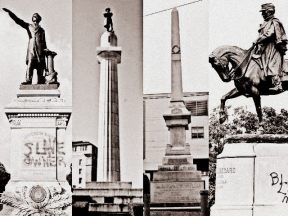 As times are slowly but surely changing, cities and states around America are attempting to do what they can to rectify the wrongdoing brought against African-Americans in the period of slavery. Last week, under the cover of darkness, masks and police protection, workers began to dismantle the first of the four statues. This is to protect themselves and their families against possible retaliation for being part of taking down what some see as a heritage site. The city plans to move forward with the removal of the remaining three monuments after the New Orleans Jazz Fest concludes on May 7th. The city of New Orleans will seek out a museum or storage area to keep them. Approximately $600,000 has been raised, in private funding, to relocate the monuments.
As times are slowly but surely changing, cities and states around America are attempting to do what they can to rectify the wrongdoing brought against African-Americans in the period of slavery. Last week, under the cover of darkness, masks and police protection, workers began to dismantle the first of the four statues. This is to protect themselves and their families against possible retaliation for being part of taking down what some see as a heritage site. The city plans to move forward with the removal of the remaining three monuments after the New Orleans Jazz Fest concludes on May 7th. The city of New Orleans will seek out a museum or storage area to keep them. Approximately $600,000 has been raised, in private funding, to relocate the monuments.
To understand the controversy, we must first understand the history of these monuments, why they were erected in the first place, and what they represent.
Liberty Monument:
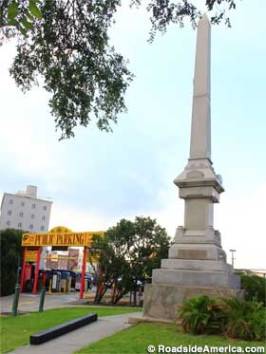 The first monument that was taken down was Liberty Monument. Built in 1891, the Liberty Monument was built to commemorate an uprising by white Democrats, who opposed racially integrating the police force and the Republicans who governed the state of Louisiana. Author Clint Smith commented on the importance of the monument on Twitter. (You can read the entire thread here.) He said, “The New Orleans government then erected the monument to commemorate the battle’s role in establishing white political dominance in Louisiana. All to say, the monument served both a symbolic & literal commemoration to white supremacy. It should have been taken down long ago.” If the history of the monument isn’t enough to convince you, consider this: the inscription on a plaque that was on the monument from 1932 up until 1993 read in part: “[…] the national election of November 1876 recognized white supremacy in the South and gave us our state.” In 1993, a vote was taken to remove the statue, but instead a new inscription replaced the old one that said: “In honor of those Americans on both sides who died in the Battle of Liberty Place” and called it “a conflict of the past that should teach us lessons for the future.”
The first monument that was taken down was Liberty Monument. Built in 1891, the Liberty Monument was built to commemorate an uprising by white Democrats, who opposed racially integrating the police force and the Republicans who governed the state of Louisiana. Author Clint Smith commented on the importance of the monument on Twitter. (You can read the entire thread here.) He said, “The New Orleans government then erected the monument to commemorate the battle’s role in establishing white political dominance in Louisiana. All to say, the monument served both a symbolic & literal commemoration to white supremacy. It should have been taken down long ago.” If the history of the monument isn’t enough to convince you, consider this: the inscription on a plaque that was on the monument from 1932 up until 1993 read in part: “[…] the national election of November 1876 recognized white supremacy in the South and gave us our state.” In 1993, a vote was taken to remove the statue, but instead a new inscription replaced the old one that said: “In honor of those Americans on both sides who died in the Battle of Liberty Place” and called it “a conflict of the past that should teach us lessons for the future.”
Statue of General Robert E. Lee:
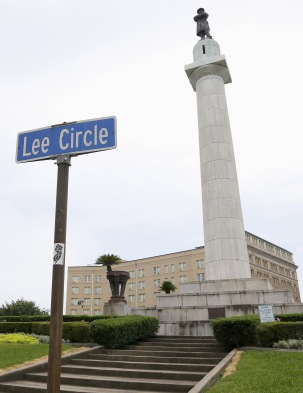
After raising the funds needed to build this monument, the statue of General Robert E. Lee was erected in 1884 in New Orleans Business District. Robert E. Lee was a general in the Civil War and was known for commanding the Confederate Army of Northern Virginia from 1862 until he surrendered in 1865. Although there are mixed accounts about whether Lee supported or opposed slavery in the southern states, under his command, troops were given permission to actively raid settlements during significant missions like in 1863 when his troops invaded Pennsylvania and were able to freely capture free blacks and put them back into the institution of slavery. New Orleans native, Wynton Marsalis said it best about the erection of Lee’s statue: “Robert E. Lee betrayed his sacred oath to support and defend the Constitution and instead chose to lead an army intent on its violent overthrow — and he lost. The Civil War was a costly victory for democracy, but long after it had been decided, the backwards thinking leadership of this city erected monuments to Confederate generals who had committed treason against the United States — and lost. Lee’s monument was erected to proclaim this arrogance across the ages, and reclaim as a victory what was lost on the battlefield.” Furthermore, Lee himself did not support erecting statues in honor of Civil War generals.
Equestrian statue of General P.G.T. Beauregard:
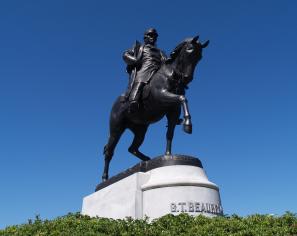
Like Robert E. Lee, P.G.T. Beauregard was a General in the Civil War. In fact, it was Beauregard who ordered the first shots of the war. Beauregard was first selected to be in charge of Charleston, South Carolina’s defenses during the Civil war and then was appointed the first Confederate general officer. He was then appointed to be a brigadier general in the Provisional Army of the Confederate States in March 1861 and then in July of the same year was promoted to full general in the Confederate Army. After the war, and perhaps surprisingly, Beauregard supported equal rights and unification. The statue, however, “depicts Beauregard the Confederate general, not Beauregard the proponent of civil rights.”
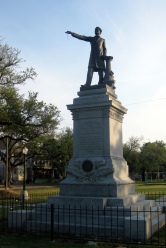 Statue of Jefferson Davis:
Statue of Jefferson Davis:
Jefferson Davis was the President of the Confederate States of America during the Civil War. He was also a Democratic U.S. Representative and Senator from Mississippi, as well as the 23rd U.S. Secretary of War. But most importantly. and why the statute is controversial, is that Davis was a plantation owner who owned slaves and financially prospered from the institution of slavery.
Protests:
Although these statues clearly represent racism and white supremacist views to many, there are still those who believe these monuments are a cultural legacy and that they are about heritage and not hate. Harcourt Fuller, assistant professor of history at Georgia State University in Atlanta, said, “Supporters of the monuments see them as part of their ‘historical and cultural legacy’ that needs to be maintained and protected.” In a city that is predominantly African-American, these statues represent a time in American history where their ancestors were treated as less than human, as “property” and nothing more. Activists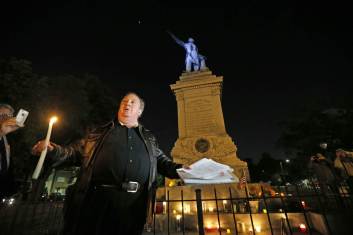 opposed to the removal of the monuments have had vigils, written articles opposing the removal, been vocal on social media platforms and had intense public meetings to argue against taking down these statues. Things have been so intense that a car of one of the employees hired to take down the monuments was set on fire. As mentioned before, those taking down the statues have had to mask their identity for fear of reprisal against them and their families for their part in this.
opposed to the removal of the monuments have had vigils, written articles opposing the removal, been vocal on social media platforms and had intense public meetings to argue against taking down these statues. Things have been so intense that a car of one of the employees hired to take down the monuments was set on fire. As mentioned before, those taking down the statues have had to mask their identity for fear of reprisal against them and their families for their part in this.
Symbols like these statues, which cause emotional trauma to some, should be kept in museums, so that they are not forgotten, but also not in public for all to see. Taking down the statues doesn’t erase what happened, but it makes clear that what happened is not to be celebrated or memorialized with monuments in honor of “the traitors who fought against the United States to uphold slavery.”
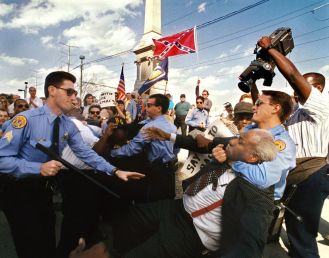 As a black woman, I totally understand why the people of New Orleans would want symbols such as these to be taken down and placed elsewhere (for those who still want to view them and who see them as cultural reminders). Seeing symbols like these around my city day in and day out would be greatly offensive to me and my heritage. Knowing what my ancestors had to go through and how they were treated for centuries and then to see these monuments would be a grave insult to my sense of identity as a black woman. It would be a constant reminder that I as a person am not valued or respected. It would feel like the leaders in my city didn’t acknowledge or care about me, my family, my ancestors and the contributions they made to build that city where we live. I applaud those in New Orleans who have worked so tirelessly to ensure these statues are removed, and I hope other cities soon follow suit.
As a black woman, I totally understand why the people of New Orleans would want symbols such as these to be taken down and placed elsewhere (for those who still want to view them and who see them as cultural reminders). Seeing symbols like these around my city day in and day out would be greatly offensive to me and my heritage. Knowing what my ancestors had to go through and how they were treated for centuries and then to see these monuments would be a grave insult to my sense of identity as a black woman. It would be a constant reminder that I as a person am not valued or respected. It would feel like the leaders in my city didn’t acknowledge or care about me, my family, my ancestors and the contributions they made to build that city where we live. I applaud those in New Orleans who have worked so tirelessly to ensure these statues are removed, and I hope other cities soon follow suit.
“After Hurricane Katrina, the support we received from people all over the world clearly demonstrated their appreciation of our culture and our character. The intensity of this love was demonstrated with unprecedented assistance of all kinds. We should transform the current Lee Circle into an inviting space that celebrates the communal intentions of the international community that helped us survive Katrina. This place would fill the heart of our city with something uplifting for us all and for all times. That, and not the stubborn echo of a shameful period of our history, should be the mythology we strive to teach to our kids and leave for our descendants.”
– Wynton Marsalis
For more information…
- New Orleans begins controversial removal of Confederate monuments
- Fighting the removal of Confederate monuments is the real ‘Lost Cause’
- New Orleans Begins Removing Confederate Monuments, Under Police Guard
- The Stubborn Persistence of Confederate Monuments
- New Orleans removes first of four Confederate statues
- With Lee statue coming down, it’s time to envision what will replace it
- Why New Orleans should take down Robert E. Lee’s statue by Wynton Marsalis
- Why do people believe myths about the Confederacy? Because our textbooks and monuments are wrong.
- Confederate monuments: Where things stand Monday
- Georgetown Apologizes, Renames Halls After Slaves
- Striking graphic reveals the construction of Confederate monuments peaked during the Jim Crow and civil rights eras
- Whose Heritage? Public Symbols of the Confederacy
- The Monuments Must Go: An Open Letter From Great, Great Grandsons of Stonewall Jackson
- How The U.S. Got So Many Confederate Monuments
- The Legacy of White Supremacy: Why Confederate Monuments Should Come Down


[…] History or Hate? The Confederate Statues of New Orleans […]
LikeLike
[…] viewed post: “History or Hate? The Confederate Statues of New Orleans” Written by Channon in May 2017, the post has received over 300 views, most of which came after […]
LikeLike